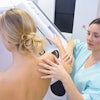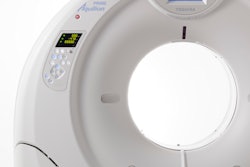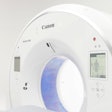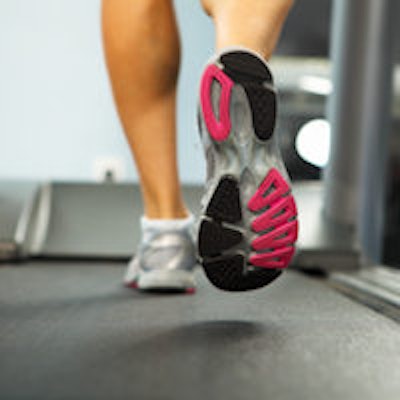
For many leading sedentary lifestyles, exercise has become a preoccupation, and its benefits are reinforced continuously by media, government, and health professionals. Radiologists are not immune to this trend, it seems. They claim they feel pressure to stay fit, but heavy workloads leave little time to exercise. In Norway, radiologists are literally taking steps to change this.
Dr. Bjørn Sudmann, consultant radiologist at the Diakonhjemmet Hospital in Oslo, is a keen cyclist and runner. Along with several like-minded colleagues, he decided that sitting stationary behind their screens was a lost opportunity. A Web search into treadmills revealed the Bwell walking machine to be a popular choice among Norwegian companies, particularly call centers.
The department was allowed to try out a machine before purchasing it, and after securing the budget from their boss to buy one machine and the funds to buy a second from the Norwegian Labor and Welfare Administration (Nye arbeids- og velferdsetaten, NAV), the group acquired two walking machines, each costing about 17,500 Norwegian Krone (2,070 euros)
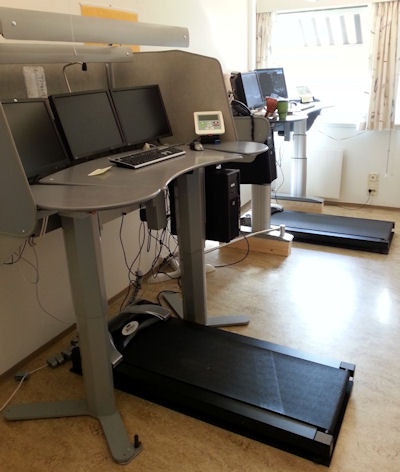 The Bwell walking machines are now an integral part of an exercise-dedicated reading room at the Diakonhjemmet Hospital in Oslo.
The Bwell walking machines are now an integral part of an exercise-dedicated reading room at the Diakonhjemmet Hospital in Oslo.The manufacturer claims these machines reduce paid sick leave from work, notably where chronic back pain is concerned, according to another of the department's "walkers" Dr. Knut Algaard, musculoskeletal consultant radiologist, who believes this was a key reason why NAV was keen to support the purchase.
The machines are used predominantly by radiologists, but all departmental staff including technicians and secretaries can use them. Installed in a separate reading room because of the noise they generate, each machine is set in front of a three-screen display terminal on a height-adjustable table. Meanwhile, the machines' own display lets users know how far they have walked. The reading room also boasts other equipment; a pull-up bar on the door frame and wall-bars for stretching and training the back and abdomen.
Concentration and productivity
But can radiologists concentrate on what they are reading? For Algaard, much depends on the speed setting of the machines, which ranges between 0 and 8 km per hour, and on the complexity of the work to be done.
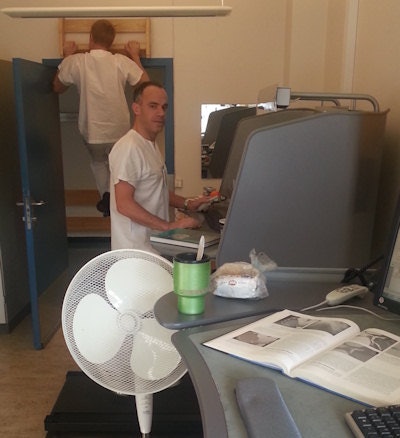 Keeping stride with both reports and the Bwell machine are Dr. Knut Algaard (facing) and colleague Dr. Erik Haavardsholm (in background).
Keeping stride with both reports and the Bwell machine are Dr. Knut Algaard (facing) and colleague Dr. Erik Haavardsholm (in background)."Walking during simple routine work like signing out a chest x-ray performed by a registrar is fine. It also works well for dictation. Evaluating an advanced malignancy while walking would be harder for me. I only walk occasionally at work, usually during my double reading for registrars. Several of my colleagues on the other hand use the machines as much as possible throughout the day," he said.
He thinks the machines are having a positive effect on the department's staff and are worth the investment, though he admits users of the machines are already health-conscious and generally lean and fit.
"All radiology departments could aim to have one machine, depending on the size of the center as radiologists are more stationary than other doctors -- even walking for an hour or so a day would help. It could even be useful for other sedentary professions such as journalists!" Algaard told AuntMinnieEurope.com.
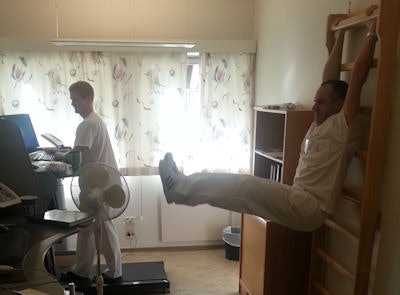 Walking for an hour or two a day can be beneficial, according to Algaard (on wall-bars), who suggests every large radiology department could purchase a treadmill to combat sedentary computer screen work.
Walking for an hour or two a day can be beneficial, according to Algaard (on wall-bars), who suggests every large radiology department could purchase a treadmill to combat sedentary computer screen work.Practical obstacles
Other radiologists raise the difficulties of exercising while at work, particularly if there isn't a dedicated space on the premises. In an anonymous, informal, straw poll of European radiologists, every respondent saw the value of regular exercise but said there was very little time for this during the working day. While a few found or made the time to go running or cycling near or around their centers during longer breaks, not all were able to do so.
"There is a small gym at our hospital, but I have never been. Working three long days plus being on call make it impossible to squeeze in extras -- but the concept is good and I would use it if I had more time. The work gym is not free, rather small, and you bump into all sorts of colleagues -- or can be seen when people walk by. It doesn't have a pool or a lot of equipment. That will be why it is underused and why some use different private gyms," said a German radiologist based in the U.K.
Others reported that staff exercise was being encouraged by their hospital's administration, through fliers and other public notices. Access to a hospital gym seems increasingly common, but many are unable to take advantage of it.
In the Netherlands, another radiologist listed 20 kinds of sport at his hospital, including swimming, badminton, power training, and spinning, and pointed to the existence of running tracks around the hospital. A radiology colleague runs every lunch time, while others attended nearby gyms, he said.
In Belgium, another respondent revealed the recent creation of a workout fitness room in the hospital made available to the personnel. However, because there was not enough time to exercise during the day, he advises doctors to workout in their spare time before or after work, two or three times a week.
A similar point was made by a U.K. radiologist.
"If feasible, cycle or walk to and from work. Personally, I cannot switch off and exercise. When I am at work, I work. When I am not at work, I exercise. Mixing the two is not for everyone," he said.
Boosting energy levels
A specialist at a large U.K. orthopedic hospital described having access to a fully equipped gym, exercise classes, and a swimming pool.
"It is theoretically possible to drop in at lunchtime, although work commitments usually prevent this. I previously cycled to work, but now have to do school runs. When I was cycling, it made a big difference to my day, mood, and boosted my energy levels. Most of my colleagues belong to a gym or other club."
Other U.K. hospitals seem to be less well-equipped, and radiologists have little time off even to eat, let alone workout.
"Benches for situps? This is the NHS [National Health Service]; we don't even have enough benches for our patients to sit on whilst they wait! And what is a lunch break? We eat packed lunches at our desks whilst checking emails on the days where we are not hosting or going to multidisciplinary team meetings or management meetings," said a senior radiologist.
Even cycling to work can prove problematic, particularly when cycle lanes are absent on the route to the hospital. The same senior radiologist explained that commuting to work by bike was impossible because of the school run, the school being on the opposite side of town from the hospital -- and both being more than 25 miles away from home. For this doctor, time for exercise was limited to walks at weekends and two or three gym visits a week.
Another Norwegian radiologist said she also exercised at work on a pull-up bar and could attend relatively cheap pilates classes available at the hospital. Her department also tried the Bwell treadmill, but found that it was too loud and there was not enough space for it.
For those wishing to combine exercise with work, but with little time to go out for cycle rides or runs, and with no dedicated space or classes offered at work, all is not lost, however.
"If I need some extra images or have to talk to another staff member, I will get up and walk to them," said another U.K.-based specialist. "Even if just walking around the department or going out to get a coffee, I return to my desk refreshed and much more focused on the reporting to be done. I will use the stairs rather than the lifts when possible. Whilst these are not formal exercise breaks, they do build exercise into my daily routine."
